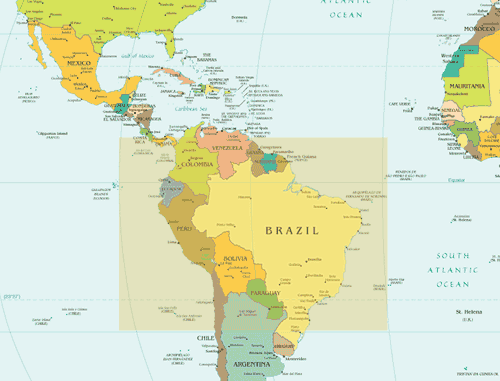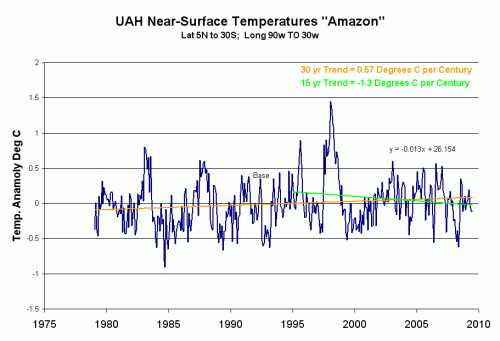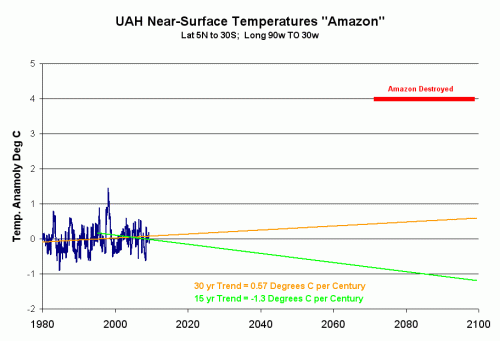Kevin Drum posted on what he called a “frightening” study about global warming positive feedback effects from drought in the Amazon. Paul Brown writes about a study published by Oliver Phillips in Science recently:
Phillips’s findings, which were published earlier this year in the journal Science, are sobering. The world’s forests are an enormous carbon sink, meaning they absorb massive quantities of carbon dioxide, through the processes of photosynthesis and respiration. In normal years the Amazon alone absorbs three billion tons of carbon, more than twice the quantity human beings produce by burning fossil fuels. But during the 2005 drought, this process was reversed, and the Amazon gave off two billion tons of carbon instead, creating an additional five billion tons of heat-trapping gases in the atmosphere. That’s more than the total annual emissions of Europe and Japan combined….
Phillips’s findings, which were published earlier this year in the journal Science, are sobering. The world’s forests are an enormous carbon sink, meaning they absorb massive quantities of carbon dioxide, through the processes of photosynthesis and respiration. In normal years the Amazon alone absorbs three billion tons of carbon, more than twice the quantity human beings produce by burning fossil fuels. But during the 2005 drought, this process was reversed, and the Amazon gave off two billion tons of carbon instead, creating an additional five billion tons of heat-trapping gases in the atmosphere. That’s more than the total annual emissions of Europe and Japan combined.
As if that’s not enough bad news, new research presented in March at a conference organized by the University of Copenhagen, with the support of the Intergovernmental Panel on Climate Change, says that as much as 85 percent of the Amazon forests will be lost if the temperature in the region increases by just 7.2 degrees Fahrenheit.
There are several questions I had immediately, which I won’t dwell on too much in this article because I have yet to get a copy of the actual study. However, some immediate thoughts:
- Studies like this are interesting, but a larger question for climate science is at what point does continuing to study only positive feedback effects in climate without putting similar effort into understanding and scaling negative feedback effects become useless? After all, it is the net of positive and negative feedback effects that matter. Deep understanding of one isolated effect in a wildly complex and chaotic system only has limited utility.
- I am willing to believe that a 2005 drought led to a 2005 reduction or even reversal of the Amazon’s ability to consume carbon. But what has happened since? It seems to me quite possible that when the rains returned, there was a year of faster than average growth, and that much of the carbon emitted in 2005 may well have been re-absorbed in the subsequent years.
- I am always suspicious of studies focusing on one area that simultaneously draw conclusions about links to certain climate effects. For example, did the biologists measuring forest growth really put an equal quality effort into showing that the drought was not caused by el Nino or other ENSO variations and was instead caused by global warming? I doubt it. I have not seen the study in question, but in every one I have seen like this the connection of the effect measured to anthropogenic global warming is gratuitous and unproven, but accepted in a peer-reviewed journal nonetheless because the core findings (in this case on forest growth) were well studied and the global warming conclusion fit the pre-conceived notions of the reviewers.
But should we worry? Will the Amazon warm 7.2F (4C) and be wiped out? Well, I thought I would look. I was prompted to run the numbers because I know that most global temperature metrics show little or no warming over the last 30 years in the tropics, but I had never seen numbers just for the Amazon area.
To get these numbers, I went to the KNMI climate explorer and pulled the UAH satellite near-surface data for the Amazon and nearby oceans. I know some folks have problems with satellite because they are only near-surface, but 30 years of history has shown that this data comes very close to following surface temperature changes, and all the surface measurement databases for this area are so riddled with holes and data gaps that they are virtually useless (trying to use the surface temperature record outside of the US and Europe and some small parts of Asia and Australia is very dangerous).
I used latitude 5N to 30S and Longitude 90W to 30W as shown on the box below:

Pulling the data and graphing it, this is what we see (click to enlarge):
Over the last 30 years, the area has seen a temperature trend of about a half degree C (less than one degree F) per century. I included the more recent trend in green because the first thing I always hear back is “well, the trend may have been low in the past, but it is accelerating!” In fact, most of this warming trend was in the first half of the period — since 1995 the trend has been negative more than a degree per century.
So how much are we in danger of hitting anywhere close to 7.2F?
I am personally worried about man destroying the Amazon, but not by CO2. My charity of choice is private land trusts that purchase land in the Amazon for preservation. I still think that is a better approach to saving the Amazon than worrying about US tailpipe emissions.



thanks for the post. Climate Depot just posted this on Amazon and tropical forests:
Climate Depot Report: Rainforest Factsheet: Clear-Cutting the Myths About the Amazon and Tropical Rainforests – ‘everting back to nature’: ‘For every acre of rainforest cut down each year, more than 50 acres of new forest are growing’ – July 8, 2009
http://www.climatedepot.com/a/1846/Climate-Depot-Report-Rainforest-Factsheet-ClearCutting-the-Myths-About-the-Amazon-and-Tropical-Rainforests
Question:
If there were a net increase of 5-billion tons of carbon because of the Great Amazonian Burp of 2005, then wouldn’t that dictate there must be a corresponding spike in observable temperature effects for the positive-feedback assumptions to be valid?
Under a Positive Feedback system:
A ==> B
5A ==> (>5)B.
I ask because we are now four years removed from the input, which has been documented and measured. If the delay in measurable effects is greater than four years, and we’re only dealing with a modern record (post-1970) of 40 years, then aren’t we shooting blind?
Is the temperature throughout the Amazon (in terms of measuring latitude-wise, elevation-wise, and seasonally) always within a 4C band? In other words, are there areas/times in the Amazon that do just fine at temperatures 4C or more greater than other areas/times?
Don’t worry about Amazonian drought. The natives used to burn it. If it burns, the ash and charcoal will sequester some carbon. When the rains return, so will the plants.
Wouldn’t the dramatic shift in the Amazon carbon budget have shown up in the Mona Loa measurements? If it did, I didn’t see it.
And doesn’t that show how small the “combined carbon emissions of the US and Japan are by comparison?
Inquiring minds want to know…
Anyway, it’s nonsense to talk about how many tonnes of CO2 per year a forest or jungle captures. Apart from short term fluctuations, a forest absorbs exactly 0 tonnes per year. Zip. As trees grow, they absorb CO2. When they die and rot away, they release every gram of CO2 they absorbed. In a steady state, the decay will equal the growth, or else the forest would be getting taller and taller, or more and more dense. Growth and decay is a cycle.
It’s the same with methane from cows. Grass grows and absorbs CO2. Cows eat the grass and release CO2 and some methane. The methane reacts with O2 in the air to give CO2. Grass grows and absorbs the CO2. In a steady state, it’s a cycle: net affect 0.
Carl Chapman
Carl Chapman,
a recent study found that old growth timber is growing again, most likely due to the increased CO2 levels.
kuhnkat: Another recent study found that there was no increase in old growth timber.
Once again AGW alarmists ignore data and choose their models.
AGW is to climate science what eugenics was to evolution.
“through the processes of photosynthesis and respiration”
Trees release CO2 in the process of respiration.
The focus of the AGW hype industry is very nomadic.
First it was warming and increased storms.
That did not work out, so they went for the melting ice.
That has not worked out, so now it is the Amazon.
When this current prediction of the apocalypse fails, inquiring minds want to know what the next focus of fear will be?
Not to long ago on Discovery Channel they showed the Natives down there using high pressure water and pumps to look for Gold. As we all know Gold prices are thru the roof so this destruction is wide spread because of Gold fever. Lot of the poor live off of what they find. The Destruction is emmense because they are removing large amounts of dirt on Hill sides destroying anything that grows. Just like they did out West in the late 1800’s here in the U.S..
The region you defined as the Amazon is actually much larger than the real Amazon and includes regions that are not dinamically linked to the Amazon, like Northern Chile desert or the Bolivian Altiplano to some extent. I don’t know how focusing on the Amazon would change your results.
Doug,
“Another recent study found that there was no increase in old growth timber.”
Since I didn’t post the study I am not asking you to either.
BUT, your statement is that their was no increase in old growth timber. My statement wat that their was increase in GROWTH OF THE old growth.
Please clarify.
Just thought I would add that many tribes in this area who do not wish to be “christianised” by god men or “integrated” by the govt seek the depths of the Amazon for safety. Deforestation not only harms the areas biodiversity but also risks the loss of these unique and fascinating tribes, such as the Wai Wai people who still hold on to their culture. I am not in the slightest bit worried about increased co2.
Previous warm periods throughout the earths history (and am talking warmer than current temps) were never warmer at the equator by current standards(sometimes cooler). The temp at the equator historically changes very little (as clouds / storms mediate the climate), even the IPCC state this in AR4, so I doubt the temperature will change there much even if the global mean increases. And observation is far more certain than an untested model projection based on some unlikely scenario.
Than there is also the added benefit of increased co2 which will allow plants there to be more tolerent of poor soils and more drought resistant. Did the Biologists consider this on their study? I wander?
Sounds like the obligatory “link it to global warming” to secure funding for some obscure research no govt would otherwise care about. Then make sure the result is alarming to ensure the paper is published without scrutiny in Nature.
Want to study the mating habits of wood lice? Want funding? Study the effects of global warming on the mating habits of wood lice instead!
Want it published in Nature? Demonstrate global warming will harm them!
One should be very sceptical of statements such as: “The world’s forests are an enormous carbon sink, meaning they absorb massive quantities of carbon dioxide, through the processes of photosynthesis and respiration. In normal years the Amazon alone absorbs three billion tons of carbon, more than twice the quantity human beings produce by burning fossil fuels.”
For the sake of simplicity, assume a world free of human depredation (as is the goal of much of environmental policy). Since forest denizens, specifically trees, have a finite life span, which is much less than the age of the earth, the earth must have rapidly reached a steady state long ago wherein the carbon acquired by living and growing trees is balanced on average by dying and decaying trees. The alternative would be a perpetually increasing mass of tree-wood until no carbon is left provide food for animal life. It stands to reason then, that the quoted statement is a half-truth; every year (on average) the Amazon forest must also release three billion tons of carbon thru plant decay. It is however, true, that reduction in the size of forests (and of fossil fuel deposits) does shrink the residual store of carbon, and this is only partly offset by the production of food crops in their place.